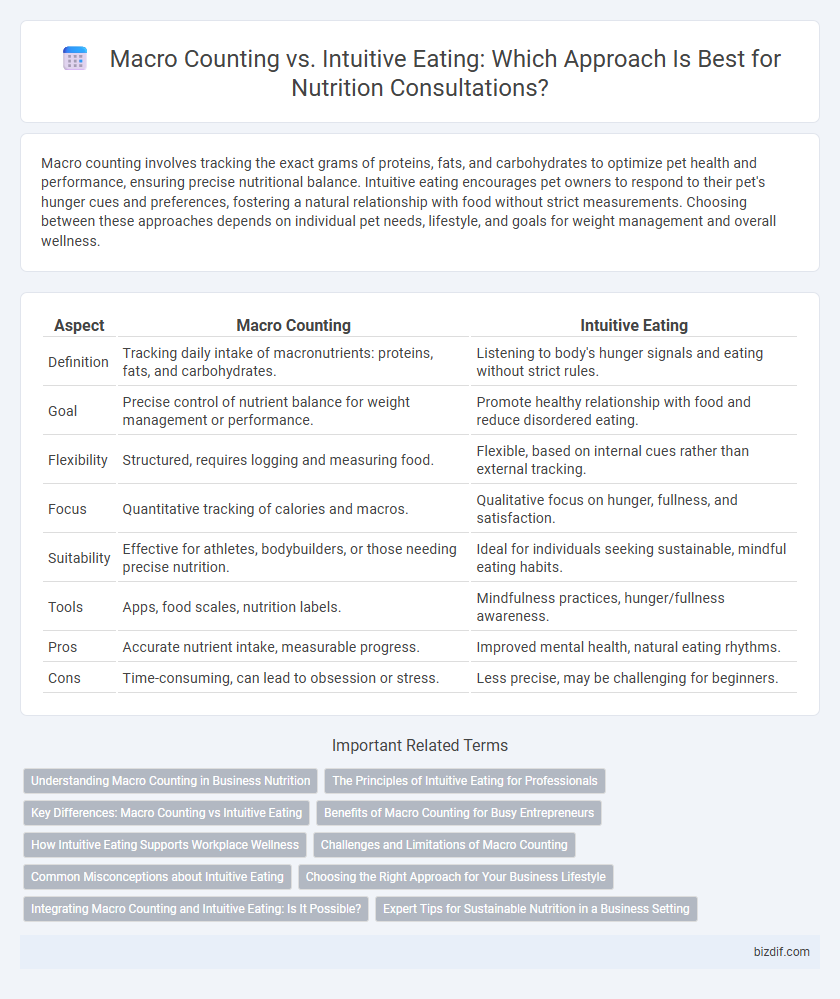Macro counting involves tracking the exact grams of proteins, fats, and carbohydrates to optimize pet health and performance, ensuring precise nutritional balance. Intuitive eating encourages pet owners to respond to their pet's hunger cues and preferences, fostering a natural relationship with food without strict measurements. Choosing between these approaches depends on individual pet needs, lifestyle, and goals for weight management and overall wellness.
Table of Comparison
| Aspect | Macro Counting | Intuitive Eating |
|---|---|---|
| Definition | Tracking daily intake of macronutrients: proteins, fats, and carbohydrates. | Listening to body's hunger signals and eating without strict rules. |
| Goal | Precise control of nutrient balance for weight management or performance. | Promote healthy relationship with food and reduce disordered eating. |
| Flexibility | Structured, requires logging and measuring food. | Flexible, based on internal cues rather than external tracking. |
| Focus | Quantitative tracking of calories and macros. | Qualitative focus on hunger, fullness, and satisfaction. |
| Suitability | Effective for athletes, bodybuilders, or those needing precise nutrition. | Ideal for individuals seeking sustainable, mindful eating habits. |
| Tools | Apps, food scales, nutrition labels. | Mindfulness practices, hunger/fullness awareness. |
| Pros | Accurate nutrient intake, measurable progress. | Improved mental health, natural eating rhythms. |
| Cons | Time-consuming, can lead to obsession or stress. | Less precise, may be challenging for beginners. |
Understanding Macro Counting in Business Nutrition
Macro counting in business nutrition involves tracking carbohydrates, proteins, and fats to optimize employee health and productivity. This method provides precise dietary guidelines based on individual energy needs and job demands, enhancing performance and reducing workplace fatigue. Implementing macro counting supports data-driven wellness strategies that align nutritional goals with organizational outcomes.
The Principles of Intuitive Eating for Professionals
The Principles of Intuitive Eating emphasize honoring hunger and fullness cues, rejecting diet mentality, and making peace with food, which supports sustainable nutrition without rigid tracking. Professionals guiding clients through intuitive eating focus on fostering body awareness, emotional regulation, and self-compassion to encourage healthier relationships with food. This approach contrasts with macro counting by prioritizing internal cues over external metrics, enhancing long-term adherence and mental well-being.
Key Differences: Macro Counting vs Intuitive Eating
Macro counting meticulously tracks protein, carbohydrates, and fats to create precise calorie targets aimed at specific health or fitness goals. Intuitive eating emphasizes listening to internal hunger cues and emotional needs, promoting a flexible approach without strict measurement of food intake. The key difference lies in macro counting's structured, quantitative method versus intuitive eating's qualitative, mindful experience.
Benefits of Macro Counting for Busy Entrepreneurs
Macro counting offers busy entrepreneurs precise control over nutrient intake, enabling optimized energy levels and improved focus throughout demanding workdays. Tracking macros supports consistent muscle maintenance and fat loss, enhancing overall physical performance without guesswork. This method simplifies meal planning, saving valuable time while promoting disciplined eating habits tailored to individual goals.
How Intuitive Eating Supports Workplace Wellness
Intuitive eating promotes workplace wellness by encouraging employees to listen to their body's hunger and fullness cues, reducing stress around food choices and improving mental health. Unlike macro counting, which can create rigid dietary rules, intuitive eating fosters a more flexible and sustainable relationship with nutrition. This approach helps enhance focus, energy levels, and overall job performance through balanced and personalized eating habits.
Challenges and Limitations of Macro Counting
Macro counting involves tracking precise intake of carbohydrates, proteins, and fats, which can be time-consuming and mentally exhausting for many individuals. This method often leads to an unhealthy obsession with numbers and may cause stress or anxiety around food choices, hindering sustainable healthy eating habits. Additionally, macro counting does not account for food quality or hunger cues, potentially limiting its effectiveness in fostering long-term intuitive and mindful eating behaviors.
Common Misconceptions about Intuitive Eating
Many individuals mistakenly believe intuitive eating means unrestricted consumption without regard to nutrition, which overlooks its focus on internal hunger cues and balanced nourishment. Another common misconception is that intuitive eating disregards health goals, whereas it actually promotes a healthy relationship with food tailored to individual needs. Understanding these nuances is essential for distinguishing intuitive eating from strict macro counting in nutrition consultation.
Choosing the Right Approach for Your Business Lifestyle
Macro counting offers precise tracking of protein, carbohydrates, and fats, making it ideal for businesses needing structured nutrition plans and measurable results. Intuitive eating encourages listening to hunger cues and promoting mental wellness, suitable for entrepreneurs prioritizing flexibility and stress reduction. Selecting the right approach depends on business goals, lifestyle demands, and client preferences for measurable progress or holistic well-being.
Integrating Macro Counting and Intuitive Eating: Is It Possible?
Integrating macro counting and intuitive eating is possible by using macro tracking as a flexible framework that supports awareness of nutrient intake without rigid restrictions. Clients can develop mindfulness around hunger and fullness cues while adjusting their macros to fit individual preferences and lifestyle. This balanced approach promotes sustainable nutrition habits and prevents the stress often associated with strict diet adherence.
Expert Tips for Sustainable Nutrition in a Business Setting
Macro counting provides precise control over nutrient intake by tracking proteins, fats, and carbohydrates, ideal for clients seeking measurable results in weight management or performance. Intuitive eating encourages mindful food choices based on hunger cues and satisfaction, fostering long-term psychological well-being and reducing disordered eating patterns. Experts recommend integrating balanced macro awareness with intuitive strategies to support sustainable nutrition habits and optimize client adherence in professional health coaching environments.
Macro Counting vs Intuitive Eating Infographic

 bizdif.com
bizdif.com